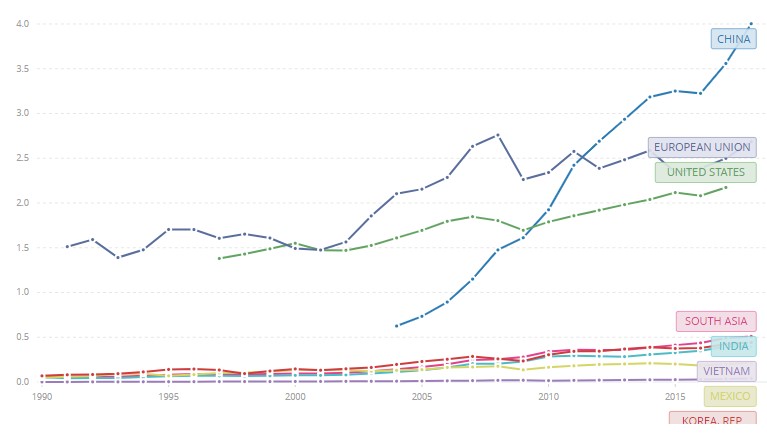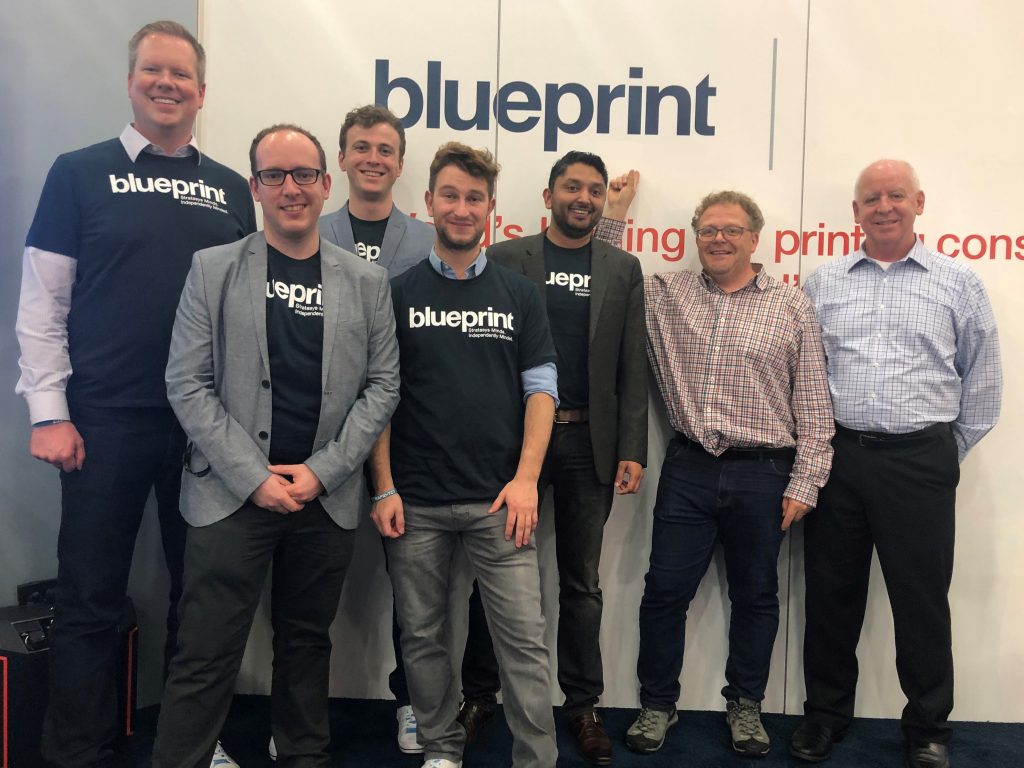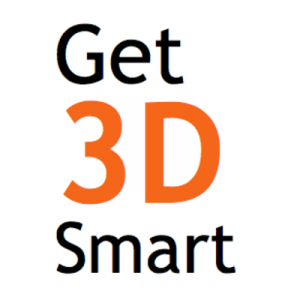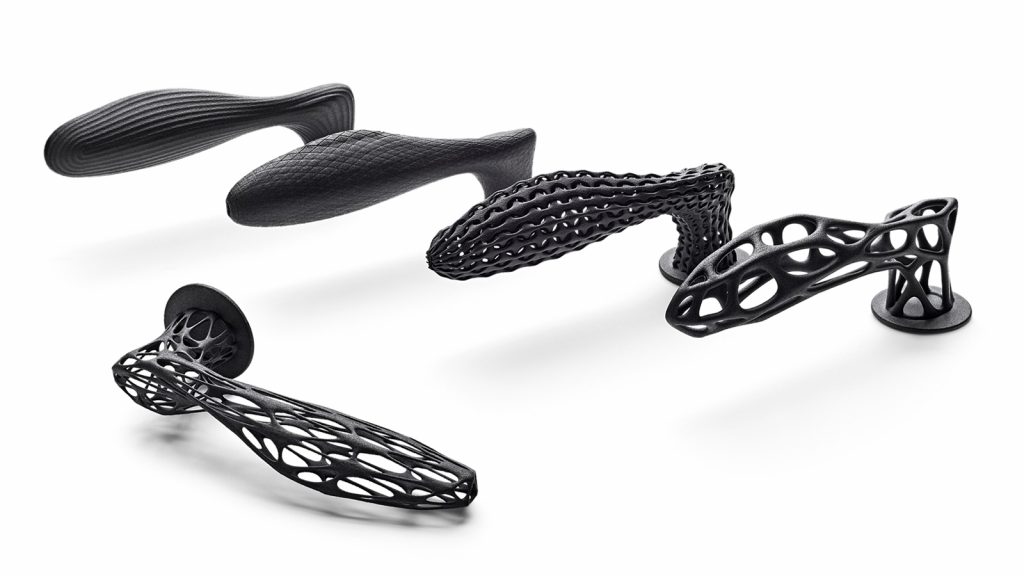The world’s manufacturers have been stretching supply chains out, becoming ever-more complex, for years now. While in eras of relatively free flow of trade, this has let countries and regions specialize in specific manufacturing types that play into their competitive advantages, the consequence is increased risk and decreased agility. This is being brutally borne out today in light of the global COVID-19 pandemic, but the problem was becoming apparent even before that, particularly with the rise of Brexit and nationalistic manufacturing policies.
Additive manufacturing, commonly known as 3D printing, approaches can help reduce risk and restore agility when supported by AI-driven insights. By digitizing traditional manufacturing, introducing dual manufacturing approaches, and building out additive as a platform, manufacturing leaders can deliver the scale and efficiency benefits of global supply chains without being one black swan event away from disaster.
Framing the problem
The global COVID-19 pandemic has dramatically altered customer demand, created workforce challenges, and disrupted global supply chains in ways that few expected. For many business leaders, this pandemic has exposed risks in their global supply chains that they had not contemplated, and indeed, that supply chain organizations were never built to handle. It is time for business leaders to start looking at the global-level risks to their supply chains and manufacturing operations.
Disruptions happen in supply chains all the time. Unfortunately, they’re most often solved at the tactical level rather than the strategic level: Sudden imposition of tariffs? Profits are slightly down next quarter. Air travel cut in Europe because of a volcanic eruption? A solvable logistics problem. Escalating conflicts in a region? A few supply chain analysts must work a few late nights to find a second source.
The risks to global supply chains have been getting more obvious for years, and companies have had to react to events like Brexit and the sudden imposition of tariffs in trade wars, but this global pandemic has removed all doubt of the need to address these risks at the strategic level.
Lots of talk, but nothing new or actionable
In the last month, there has been growing interest in global supply chain risk, with articles in Harvard Business Review and the MIT Sloan Management Review publishing notable examples. The global problem is recognized.
Many have focused on how artificial intelligence, analytics, and even blockchain technologies can help mitigate these urgent risks. Indeed, AI and analytics solutions can help you understand volumes, production variability, escalating costs, or how much of your bill of materials is dependent on a commodity price. You can and should use these tools to optimize your supply chain, but they are just that: optimization tools; they break down when you uncover problems that require a new framing or need new and novel solutions.
Indeed, we’re uncovering a new problem: Over the last three decades, the relative free flow of trade has meant that manufacturing has concentrated in countries with comparative advantage in manufacturing that type of commodity. (One might expect that manufacturing in the west has declined in absolute terms with the rise of China; it hasn’t.) This means that structurally, how the world manufactures are highly-coupled to geography and is built on a model that targets efficiency at very specific production volumes. Manufacturers are unprepared to respond to global-scale threats (and opportunities) because of this strong coupling to geography and volume.
The need for a solution to macro-level risks
Supply chain analysts have historically been very good at understanding and addressing the micro-level risks associated with supply chains: Stock-outs, risk of a single supplier dropping out, commodity price increases… Consequently, the supply chain management industry has developed a suite of tools to address this: safety stock, dual sourcing, price guarantees, commodity hedges, competitive bidding, etc.

What the global disruptions caused by the COVID-19 pandemic show us is that supply chain professionals have not been very great at understanding and assessing the macro-level risks associated with their manufacturing supply chains. What happens when disruption happens at country-, regional-, or global-scale? Clearly business leaders need to start contemplating these questions.
A better way to frame the problem
Start by acknowledging that most manufacturing is difficult to move once set up, so planners must predict the future and contemplate this risk over the life of a production line. Unfortunately, almost every macro-level risk to production is related to geography: Tariffs, labor disruptions, commodity unavailability, logistics breakdown. How do you tell if risk is geographic? Ask the question: If we could instantly move our production to somewhere else in the world, would this problem be solved? If the answer is yes, then the risk relates to geography.
Second, an often-overlooked element of risk is global demand. We’ve seen in the past several months that demand can be highly variable and spike (in the case of toilet paper) or drop (in the case of airplanes) dramatically in response to a crisis. It is not just in times of crisis that demand is variable; most product companies will experience a spike of demand upon release, and a tapering-off as a product matures, with consequences for production economies.
Finally, we define companies’ ability to respond to changes in geographic or demand risk as “agility.” In a supply chain context, this is the speed with which manufacturers can shift production between geographies and the ability to quickly adjust production within a wide range of volumes. The tools that enable manufacturing agility often help address both demand and geographic risk, so we’ll conceptualize those in a single bucket.
Conceptually, you can think of this framework as being summarized in a simple equation:
Thinking of risk in this way, we can start to understand what the risks are, what flexibility is needed to address this risk, and what questions we should be asking within our businesses and to our suppliers:
|
Risk |
Flexibility needed |
Questions to ask? |
|
Geographic risk – Risks of disruptions to supply chain based on national, regional, or global factors. Risks could include disruptions caused by labor market dynamics, tariffs, war, pandemics, natural disasters, factory input shortages, political factors. |
Geographic flexibility – The ability to move or shift production from one geography to another. |
Where are my suppliers? Where are my second- and third-tier suppliers? What borders do my supply chains cross? Do I manufacture in more than one geography? What are the economic factors that cause us to produce where we do? |
|
Demand risk – Risks of radical increases or decreases in demand, either regionally or globally. Demand shifts could be localized or global and be caused by fiscal and economic policy, market competitive forces, economic pressures, pandemics, natural disasters, conflicts |
Volume flexibility – The ability to economically produce goods across a wide range of volumes. |
What is the event that could happen that will reduce demand the most? How quickly can we scale-down production? What fixed costs are we incurring, regardless of demand? What event could cause the greatest spike in demand? Could that demand spike be regional? How quickly can we scale up production? Given our production capacity, what is the ceiling of production before more investment is needed? |
The conclusion from this framework is simple: If business leaders in manufacturing reduce their dependence on geography, create manufacturing infrastructure that is less dependent on specific levels of production, and increase their ability to respond quickly, they will reduce their manufacturing risk, be ready to respond to the next crisis, and be more prepared to take advantage of future opportunities.
Enter 3D Printing
Additive manufacturing is not simply about purchasing some 3D printers. It is, in fact, a manufacturing process that can be applied strategically to address manufacturing risk particularly by optimizing the denominator in our equation – agility.
Some of the well-known advantages of 3D printing involve the ability to have similar economics at any scale, or to produce line-side at the point of need, but 3D printing is neither a blanket solution, nor the only way that you can reduce risk from geography and demand and increase agility. But it is a very good tool in some cases. Here are three cases you should consider as part of your manufacturing strategy.
Digitization of traditional manufacturing toolsets
Rather than replace traditional manufacturing with 3D printing, look to 3D printing to digitize the process. Many manufacturers use 3D printing for manufacturing jigs and fixtures, but applications can go beyond that: Specialized tooling, job aids, molds for direct production, and machine service parts are some of the applications we have seen at our clients.
The advantages to digitization of your manufacturing toolset are twofold: In an event where you need to switch production to another geography, the number of things that you need to pack up and ship somewhere is reduced. Further, if you have the need to scale, printing additional molds and toolsets can enable your operation to do that rapidly.
The more components of your traditional manufacturing process can be digitized, the more agile your manufacturing operation is and the less coupled to geography your business becomes.
Dual Manufacturing
Dual manufacturing can be summarized as follows: Designing and qualifying functionally equivalent parts for two manufacturing processes, one process that is efficient at volume, and one process that is efficient at unit-scale. The advantages of this come from the fact that many traditional manufacturing methods require capacity to be deployed in blocks and are most efficient when these blocks of capacity are fully utilized. An injection molding setup that can produce 20,000 pieces a day is most cost-efficient when running at full capacity. Producing 20,001 pieces a day requires an additional fixed investment and wasted capacity of an additional setup. Under a dual manufacturing concept, additive manufacturing is used to augment traditional production until traditional manufacturing can be deployed at scale.
This concept isn’t only applicable in a crisis and we see it as relevant at several points in the normal production cycle:
- Early production – Low volume production of the first units for review, trade shows, product launches
- Peak production – Augment traditional production to meet peak demand where excess traditional manufacturing capacity would otherwise need to be built
- Aftermarket – Production at low volumes for servicing aftermarket needs.
An additional advantage is that, once you have contemplated dual manufacturing, you can make strategic decisions about how closely you want to couple your manufacturing to a given production scale. Shifting more production to additive, or similar technologies, can reduce your risk to fluctuations in demand.
Employing a dual manufacturing concept simultaneously reduces risk to both geography and demand. By designing for a platform that can be deployed anywhere in the world, you decrease your geographic exposure. Likewise, by adding a manufacturing method that is similarly efficient across any volume to your manufacturing toolset, you increase your ability to produce to fluctuating demand.
Additive as a platform
Businesses that think of additive manufacturing as a platform can decouple themselves from fixed investment in geography and volume commitments. Once a machine and material are selected, a lot of the complexity in manufacturing is abstracted by that machine; rather than requiring tooling and separate processes for every part, the tooling and processes become largely standardized. As the number of parts that are designed for your “additive platform” increases, your manufacturing capacity becomes exponentially more flexible; any platform-compliant additive machine can produce any part designed for the platform. Additionally, an additive platform can be deployed incrementally, or augmented by any one of hundreds of global service bureaus.
Summary
During times of uncertainty, the default playbook for many business leaders is to cut budgets and weather the storm; eventually the economy will turn around, demand will bounce back, trade disputes will be resolved, and we can get back to business.
In contrast, we recommend using this as an opportunity to reassess manufacturing supply chains. We think that forward-looking business leaders will make this choice.
By contemplating tools that reduce exposure to geographic and demand risk, as well as increase the ability of manufacturing to respond, business leaders can both be ready for the next macro-level disruption in their supply chain and be able to act on opportunities once we emerge from the global Covid-19 pandemic.
While we have shared some ways in which 3D printing can help you alter your supply chain risk equation by decreasing exposure to geographic and demand risk, and increasing your agility, the examples above are only some of the ways that one tool can assist a much larger initiative. Pivoting manufacturing away from risk and toward agility will require support at all levels, from the C-suite to the manufacturing floor: Executives must look at and evaluate risks they never considered before, designers must contemplate the design freedoms (and constraints) of new tools, product managers must consider the economics of production across a range of volumes and geographies, engineers must learn how to design for additive, and supply chain must learn to “source” parts in ways they never contemplated before.
For organizations willing to change how they think about manufacturing, this will be a multi-year journey, but the rewards are obvious: Lowered exposure to country, regional, and global macro-level supply chain risk and the ability to be more responsive to your customers and markets. And if you don’t do it, one of your competitors almost certainly will.
Aaron Hurd (Senior Manager, Blueprint)
Aaron is a Senior Manager with Blueprint, where he helps clients understand how additive manufacturing impacts their strategy, supply chain, engineering, and manufacturing processes. He holds an MBA from the University of Michigan and an engineering degree from Iowa State University.
Kunal Mehta (Managing Director of Blueprint)
Kunal is responsible for leading the global business of Blueprint and focuses on driving adoption of 3D printing across start-ups, Fortune 500s and governments. With his extensive experience deploying numerous emerging technologies, Kunal possesses a unique perspective in helping organizations achieve high performance by designing and executing additive strategies to reshape their manufacturing processes – consistently providing customers with a differentiated, more profitable, and more satisfying experience.
Blueprint is an additive manufacturing consultancy, bringing together more than 16 years of knowledge and experience across the industry. As the world’s leading additive manufacturing consultancy, Blueprint regularly assists future-ready companies achieve additive success. Based in Eden Prairie, Minn., and Milford, U.K, the firm offers a unique, technology-agnostic perspective on all things additive, from strategic advice to design optimization services. More information is available online at www.additiveblueprint.com.
If you want to discuss this article or your additive manufacturing strategy, the team at Blueprint is here to help. Let’s talk.
References:
https://sloanreview.mit.edu/article/is-it-time-to-rethink-globalized-supply-chains/
https://hbr.org/2020/03/coronavirus-is-proving-that-we-need-more-resilient-supply-chains
The post 3D Printing is Additive to Supply Chain Agility appeared first on 3DPrint.com | The Voice of 3D Printing / Additive Manufacturing.











